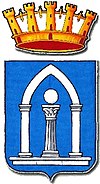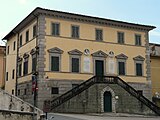Pietrasanta
| Pietrasanta | ||
|---|---|---|

|
|
|
| Country | Italy | |
| region | Tuscany | |
| province | Lucca (LU) | |
| Coordinates | 43 ° 57 ' N , 10 ° 14' E | |
| height | 14 m slm | |
| surface | 42 km² | |
| Residents | 23,542 (Dec. 31, 2019) | |
| Population density | 561 inhabitants / km² | |
| Post Code | 55045 | |
| prefix | 0584 | |
| ISTAT number | 046024 | |
| Popular name | Pietrasantini | |
| Patron saint | San Biagio and San Martino | |
| Website | Pietrasanta | |
 Pietrasanta, Piazza del Teatro |
||
Pietrasanta is a small Italian town with 23,542 inhabitants (as of December 31, 2019) in the province of Lucca in northern Tuscany .
geography
Pietrasanta is about 30 km north of Pisa at the foot of the Apuan Alps . The district of Marina di Pietrasanta by the sea is a well-known seaside resort.
The municipality includes the districts of Capezzano Monte, Capriglia, Strettoia (Montiscendi), Traversagna (Pollino), Vecchiuccio, Vallecchia, Solaio, Vitoio, Castello, Valdicastello, Crociale (Ponte Rosso), Africa (Pisanica), Macelli, Osterietta and Marina di Pietrasanta (Fiumetto, Tonfano, Motrone, Focette).
The neighboring municipalities are Camaiore , Forte dei Marmi , Montignoso (MS), Seravezza and Stazzema .
history

Remnants of the wall indicate settlement as early as Roman times. The city was founded in 1255, when the Milanese Guiscardo Pietrasanta, namesake of the place, had a settlement built at the foot of an already existing Lombard fortress. In the Middle Ages, rulership changed several times between the city-states of Genoa , Lucca and Florence . After an arbitration, by decision of Pope Leo X of the Medici family in 1513, Pietrasanta and its area with the port of Motrone - at that time the only one in Versilia - came to Florence, under whose rule it remained until the unification of Italy. A period of decline followed in the 17th and 18th centuries, partly due to malaria .
Leopold II , Grand Duke of Tuscany and Archduke of Austria, promoted the reconstruction in the 19th century and created the economic basis for the return to its former importance as the city of marble by setting up schools for stonemasons .
economy
Marble processing
The name Pietrasanta (Italian pietra : stone, santa : holy) says it all. In fact, stone processing is of particular importance here . In the nearby marble quarries of Carrara , one of the world's best sculptor marbles called Statuario is quarried, which is processed in many companies in and around Pietrasanta. Less pure, white and gray varieties of the marble extracted there are also cheap and practical building materials in Pietrasanta. Many everyday objects in the city such as window sills, mailboxes, sidewalks, electrical boxes or garbage bins are made of the finest white marble.
Sculpture and handicrafts
Quite a number of stonemasons, sculptors and other artists who work with stone have settled here. One of these well-known artists is Fernando Botero . However, marble is not the only material used in handicrafts. Many artists, almost all of them very elderly Italians, work with other materials, especially copper and glass , with which artistic mosaics are laid.
The local workshops mostly have an excellent, partly international reputation. Well-known personalities such as Silvio Berlusconi and Pope John Paul II have commissioned statues. Interestingly enough, George W. Bush and Saddam Hussein had placed orders with the same workshop almost at the same time.
Attractions
- The Cathedral of San Martino was built in the 14th century on the site of an earlier church and restored and modified in the 17th and 19th centuries. The campanile dates from the 16th century.
- The clock tower was built between 1530 and 1533, and was given its current appearance in 1860.
- The church of Sant'Agostino , a monastery church of the Augustinian canons, was built in the 14th century in the Romanesque style. The tower dates from 1780. Today the building is a cultural center with a library and a museum, which houses, among other things, the work Immacolata Concezione by Astolfo Petrazzi .
- There are many palazzi worth seeing on Cathedral Square, including the Palazzo Moroni from the 17th century, which now houses the Archaeological Museum, and the Palazzo Panicchi from the 15th century.
- In the little church della Misericordia has Fernando Botero 1993, two frescoes with the titles La Porta del Paradiso and La Porta dell'Inferno painted, representing the gates to paradise and hell.
Hell fresco by Fernando Botero
Community partnerships
Pietrasanta has partnerships with the following cities and municipalities:
| city | country |
|---|---|
| Écaussinnes |
|
| Grenzach-Wyhlen |
|
| Montgomery |
|
| Villeparisis |
|
| Zduńska Wola |
|
sons and daughters of the town
- Eugenio Barsanti (1821–1864), engineer and co-inventor of an internal combustion engine
- Giosuè Carducci (Enotrio Romano; 1835–1907), poet and literary historian, was born in the district of Valdicastello; received the Nobel Prize for Literature in 1906
- Cesare Galeotti (1872–1929), composer, conductor and pianist
- Carlo Ripa di Meana (1929–2018), environmental and European politician
- Santino Spinelli , stage name Alexian (* 1964), musician and composer
- Nicola Vizzoni (* 1973), Olympic second and vice European champion in hammer throwing
- Francesca Piccinini (* 1979), volleyball player
- Luca Tesconi (* 1982), marksman
- Irene Fornaciari (* 1983), singer
- Giulio Donati (* 1990), football player
Web links
Individual evidence
- ↑ Statistiche demografiche ISTAT. Monthly population statistics of the Istituto Nazionale di Statistica , as of December 31 of 2019.
- ↑ Sistema Informativo Unificato per le Soprintendenze Archivistiche: Comune di Pietrasanta , accessed on July 11, 2019 (Italian)
- ↑ Comune di Pietrasanta - Città gemellate. Retrieved May 15, 2016 .
← Previous location: Massa 15.8 km | Pietrasanta | Next town: Camaiore 8.2 km →
![]() Canterbury |
Dover |
Calais |
Wissant |
Guînes |
Licques |
Wisques |
Thérouanne |
Auchy-au-Bois |
Bruay-la-Buissière |
Arras |
Bapaume |
Peronne |
Doingt |
Seraucourt-le-Grand |
Tergnier |
Laon |
Bouconville-Vauclair |
Corbeny |
Hermonville |
Reims |
Trépail |
Châlons-en-Champagne |
Cool |
Brienne-le-Château |
Bar-sur-Aube |
Châteauvillain |
Blessonville |
Langres |
Humes-Jorquenay |
Coublanc |
Grenant |
Dampierre-sur-Salon |
Savoyeux |
Seveux |
Gy |
Cussey-sur-l'Ognon |
Besançon |
Étalans |
Chasnans |
Nods |
Ouhans |
Pontarlier |
Yverdon-les-Bains |
Orbe |
Lausanne |
Cully |
Vevey |
Montreux |
Villeneuve |
Aigle |
Saint-Maurice |
Martigny |
Orsières |
Bourg-Saint-Pierre |
Great St. Bernhard |
Saint-Rhémy-en-Bosses |
Saint-Oyen |
Étroubles |
Gignod |
Aosta |
Saint-Christophe |
Quart |
Nut |
Verrayes |
Chambave |
Saint-Denis |
Châtillon |
Saint-Vincent |
Montjovet |
Issogne |
Verrès |
Arnad |
Hône |
Bard |
Donnas |
Pont-Saint-Martin |
Carema |
Settimo Vittone |
Borgofranco d'Ivrea |
Montalto Dora |
Ivrea |
Cascinette d'Ivrea |
Burolo |
Bollengo |
Palazzo Canavese |
Piverone |
Azeglio |
Viverone |
Roppolo |
Cavaglià |
Santhià |
San Germano Vercellese |
Olcenengo |
Salasco |
Sali Vercellese |
Vercelli |
Palestro |
Robbio |
Nicorvo |
Castelnovetto |
Albonese |
Mortara |
Cergnago |
Tromello |
Garlasco |
Gropello Cairoli |
Villanova d'Ardenghi |
Zerbolò |
Carbonara al Ticino |
Pavia |
Valle Salimbene |
Linarolo |
Belgioioso |
Torre de 'Negri |
Costa de 'Nobili |
Santa Cristina e Bissone |
Miradolo Terme |
Chignolo Po |
San Colombano al Lambro |
Orio Litta |
Senna Lodigiana |
Calendasco |
Rottofreno |
Piacenza |
Podenzano |
San Giorgio Piacentino |
Pontenure |
Carpaneto Piacentino |
Cadeo |
Fiorenzuola d'Arda |
Chiaravalle della Colomba |
Alseno |
Busseto |
Fidenza |
Costamezzana |
Noceto |
Medesano |
Fornovo di Taro |
Terenzo |
Berceto |
Pontremoli |
Filattiera |
Villafranca in Lunigiana |
Bagnone |
Licciana Nardi |
Aulla |
Santo Stefano di Magra |
Sarzana |
Castelnuovo Magra |
Ortonovo |
Luni |
Fosdinovo |
Carrara |
Massa |
Montignoso |
Seravezza |
Pietrasanta |
Camaiore |
Lucca |
Capannori |
Porcari |
Montecarlo |
Altopascio |
Castelfranco di Sotto |
Santa Croce sull'Arno |
Ponte a Cappiano |
Fucecchio |
San Miniato |
Castelfiorentino |
Coiano |
Montaione |
Gambassi Terme |
San Gimignano |
Colle di Val d'Elsa |
Badia a Isola |
Monteriggioni |
Siena |
Monteroni d'Arbia |
Ponte d'Arbia |
Buonconvento |
Montalcino |
Torrenieri |
San Quirico d'Orcia |
Bagno Vignoni |
Castiglione d'Orcia |
Radicofani |
San Casciano dei Bagni |
Abbadia San Salvatore |
Piancastagnaio |
Ponte a Rigo |
Proceno |
Acquapendente |
Grotte di Castro |
San Lorenzo Nuovo |
Bolsena |
Montefiascone |
Viterbo |
Ronciglione |
Vetralla |
Capranica |
Sutri |
Monterosi |
Nepi |
Mazzano Romano |
Campagnano di Roma |
Formello |
La Storta |
Rome
Canterbury |
Dover |
Calais |
Wissant |
Guînes |
Licques |
Wisques |
Thérouanne |
Auchy-au-Bois |
Bruay-la-Buissière |
Arras |
Bapaume |
Peronne |
Doingt |
Seraucourt-le-Grand |
Tergnier |
Laon |
Bouconville-Vauclair |
Corbeny |
Hermonville |
Reims |
Trépail |
Châlons-en-Champagne |
Cool |
Brienne-le-Château |
Bar-sur-Aube |
Châteauvillain |
Blessonville |
Langres |
Humes-Jorquenay |
Coublanc |
Grenant |
Dampierre-sur-Salon |
Savoyeux |
Seveux |
Gy |
Cussey-sur-l'Ognon |
Besançon |
Étalans |
Chasnans |
Nods |
Ouhans |
Pontarlier |
Yverdon-les-Bains |
Orbe |
Lausanne |
Cully |
Vevey |
Montreux |
Villeneuve |
Aigle |
Saint-Maurice |
Martigny |
Orsières |
Bourg-Saint-Pierre |
Great St. Bernhard |
Saint-Rhémy-en-Bosses |
Saint-Oyen |
Étroubles |
Gignod |
Aosta |
Saint-Christophe |
Quart |
Nut |
Verrayes |
Chambave |
Saint-Denis |
Châtillon |
Saint-Vincent |
Montjovet |
Issogne |
Verrès |
Arnad |
Hône |
Bard |
Donnas |
Pont-Saint-Martin |
Carema |
Settimo Vittone |
Borgofranco d'Ivrea |
Montalto Dora |
Ivrea |
Cascinette d'Ivrea |
Burolo |
Bollengo |
Palazzo Canavese |
Piverone |
Azeglio |
Viverone |
Roppolo |
Cavaglià |
Santhià |
San Germano Vercellese |
Olcenengo |
Salasco |
Sali Vercellese |
Vercelli |
Palestro |
Robbio |
Nicorvo |
Castelnovetto |
Albonese |
Mortara |
Cergnago |
Tromello |
Garlasco |
Gropello Cairoli |
Villanova d'Ardenghi |
Zerbolò |
Carbonara al Ticino |
Pavia |
Valle Salimbene |
Linarolo |
Belgioioso |
Torre de 'Negri |
Costa de 'Nobili |
Santa Cristina e Bissone |
Miradolo Terme |
Chignolo Po |
San Colombano al Lambro |
Orio Litta |
Senna Lodigiana |
Calendasco |
Rottofreno |
Piacenza |
Podenzano |
San Giorgio Piacentino |
Pontenure |
Carpaneto Piacentino |
Cadeo |
Fiorenzuola d'Arda |
Chiaravalle della Colomba |
Alseno |
Busseto |
Fidenza |
Costamezzana |
Noceto |
Medesano |
Fornovo di Taro |
Terenzo |
Berceto |
Pontremoli |
Filattiera |
Villafranca in Lunigiana |
Bagnone |
Licciana Nardi |
Aulla |
Santo Stefano di Magra |
Sarzana |
Castelnuovo Magra |
Ortonovo |
Luni |
Fosdinovo |
Carrara |
Massa |
Montignoso |
Seravezza |
Pietrasanta |
Camaiore |
Lucca |
Capannori |
Porcari |
Montecarlo |
Altopascio |
Castelfranco di Sotto |
Santa Croce sull'Arno |
Ponte a Cappiano |
Fucecchio |
San Miniato |
Castelfiorentino |
Coiano |
Montaione |
Gambassi Terme |
San Gimignano |
Colle di Val d'Elsa |
Badia a Isola |
Monteriggioni |
Siena |
Monteroni d'Arbia |
Ponte d'Arbia |
Buonconvento |
Montalcino |
Torrenieri |
San Quirico d'Orcia |
Bagno Vignoni |
Castiglione d'Orcia |
Radicofani |
San Casciano dei Bagni |
Abbadia San Salvatore |
Piancastagnaio |
Ponte a Rigo |
Proceno |
Acquapendente |
Grotte di Castro |
San Lorenzo Nuovo |
Bolsena |
Montefiascone |
Viterbo |
Ronciglione |
Vetralla |
Capranica |
Sutri |
Monterosi |
Nepi |
Mazzano Romano |
Campagnano di Roma |
Formello |
La Storta |
Rome![]()
![]()
![]()










